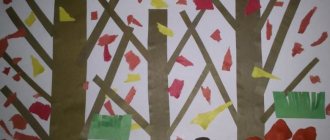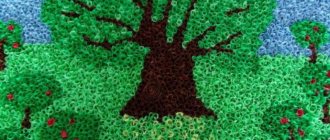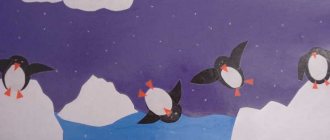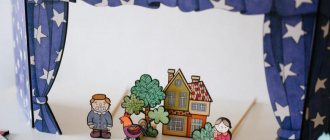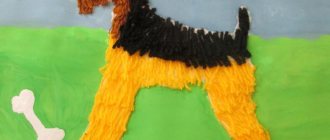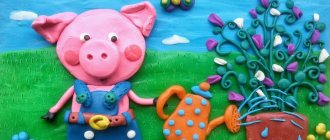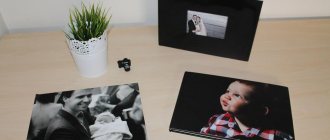Application is an excellent activity designed to comprehensively develop a child. Break applique is a separate direction. All age groups can use this technique, but it is most useful and interesting for children of primary preschool age. At this age, the development of fine motor skills is important for the development of a child, which this activity does an excellent job of. Let's look at examples and operating principles.
Bunny made of paper
To create such a craft, pre-prepared templates with images of animals are perfect. In the photo of the broken appliqué you can see a bunny; thanks to the use of this technique, an interesting texture is created, the character looks more voluminous.
To create beautiful crafts, you can take templates by cutting them out of magazines, old coloring books, or print them from the Internet. You can also draw the figure yourself on paper or cardboard.
Crafts technique:
- Tear off the paper strips and then finely tear them into pieces.
- Glue these elements like a mosaic onto a pre-printed or drawn image.
- Try to make small distances between the pieces so that they do not overlap each other.
- The nose and eyes can also be torn from dark-colored paper or drawn on.
- Makes a great craft!
Examples of finished works
The finished cut-out appliqué looks very much like a mosaic, especially if there is little space left between the pieces of paper. Here are examples of such applications:
For older children or schoolchildren, you can choose more serious subjects. In Ancient History lessons, the teacher may well suggest making Egyptian frescoes out of paper!
In general, cut-out applique as a type of children's creativity is quite suitable for kindergartens, aesthetic centers, and lower grades of school.
An alternative material for making cut-out appliqué can be multi-colored double-sided tape or adhesive-backed note paper. Scotch tape, of course, is a more expensive method, but the baby will not need to get dirty with glue. Simply tear off a piece, remove the base and stick it on paper. Ideal for kindergarten!
Snowman
Prepare a sheet of white paper and draw snowdrifts on it.
- Tear them off with your hands, following the drawn line.
- Now cut it into two parts.
- Blue or light blue cardboard will play the role of a background; stick snowdrifts on it.
- Attach different parts on top of each other to make the result look more realistic.
- Make templates with snowman parts from white paper.
- Carefully tear off the blanks along the pencil outline.
- You can glue the resulting circles to make a snowman; try to put the bottom border on the snowdrift to “put” the snowman on the snow.
- Cut out a headdress for a snowman from colored paper, buttons and parts of the face can be drawn with felt-tip pens.
- Decorate the craft further as you wish.
Other application options
You can create entire paintings using the cut appliqué technique. This technique is perfect for children in the preparatory group of kindergarten.
You can tear off pieces, cut them and arrange them randomly. You can also beautifully outline the contours with markers or felt-tip pens and design an applique inside the image.
Lesson notes on the “Carrot” appliqué, cf. gr
Lesson notes on the “Carrot” appliqué, cf. gr
Target. Creating a “Carrot” applique using the cutting method.
Tasks. Continue teaching children how to work using the cut-out appliqué technique to create a simple “Carrot” composition. Teach children to identify familiar objects by touch (models of vegetables). To consolidate children's knowledge of where vegetables grow. Strengthen the ability to politely express your request. Develop tactile perception and fine motor skills of the fingers. Develop imagination and the ability to make assumptions. Develop independence, accuracy and consistency in performing your work.
Material. Toy hare, dummies of vegetables, teaching aid “Wonderful Bag”. Supplies for applique for each child: half a sheet of colored cardboard with a drawn silhouette of a carrot and glued tops, a small piece of red/orange paper, glue, glue brushes, rags or paper napkins.
Preliminary work: role-playing game “Fruit and Vegetable Store”; didactic game “What grows where?”; guessing riddles on the topic “Vegetables”; appliqués using the cutting method: “Turnip”, “Kolobok is rolling along the path”; outdoor game “Wolf and Hare”; finger game “Visiting the big toe.”
GCD move.
Educator: Guys, do you like it when guests come to you?
Children: Yes, we love it!
Educator: Do you like to visit?
Children: Yes
Educator: Let's play our familiar game, which is called “Visiting the Thumb.”
Finger game “Visiting the big finger” Visiting the big finger (Put your thumbs up.) Came straight to the house (Join the fingertips of both hands at an angle “roof.”) Index and middle, Ring and last. The little finger itself (called fingers, alternately connect with the big one, lightly massaging them, on both hands at the same time.) Knocked on the threshold. (Clench your fists, put your little fingers up, move them.) Together your fingers are friends, They cannot be without each other. Strong, friendly - (Rhythmically clench and unclench your fingers on both hands.) Everyone needs them so much! (Children clap their hands.)
Educator: Well done guys, they played well, it was fun! Game situation “Letter”
Educator: Look at what a beautiful envelope we have on our shelf, and next to it an interesting bag. Let's read the letter from the envelope. (One of the children opens the envelope and hands the letter to the teacher.) The teacher reads the letter: “Hello, guys, I am your unfamiliar friend. I really want to come visit you, but I won’t be able to do this until you guess what’s in this wonderful bag...”
Educator:
What do you think might be in it? Presumable answers of the children: “There are toys in the bag”; “...dishes”, etc.
The teacher continues to read: “My bag opens very easily. He must be politely asked about this and the appropriate magic word must be said. But don't look into it! Otherwise I won’t be able to get to you! You simply put your hands into the bag, take any one object and try to recognize it without taking your hands out of the bag, by touch. If you guess correctly and name all the objects, I can come to visit you and play with you. Your unknown friend."
Educator: Do you want a guest to come to us?
Children: (Yes, we want!)
Educator : Then let's politely ask the bag to open. Several children ask the bag to open using the accepted form of address. (Pouch, please open. Pouch, please open.)
Didactic game “Wonderful bag”. Children try to determine by touch what is in the bag. All correctly named items are placed on a separate table.
Educator: Look how much was in the bag, this is - ..., and - ... Let's think, how can all this be called in one word? Individual appeals to children: “What do you think? What do you think?" There is no need to rush to confirm the child’s correct answer so that other children have a reason to think. After several correct answers, the teacher praises the children, confirming that they are right: “Well done, guys, of course, these are vegetables!”
Educator: Do you know where vegetables grow? (“Vegetables grow in the garden.” We try to get complete answers from the children.)
The teacher draws attention to the toy hare. Look, there’s a little white bunny sitting right there, looking at us from the shelf, that’s the joker, where’s he hiding? Bunny: Hello, guys, I’m very glad that I was able to visit you! Because you correctly identified all the vegetables and said where they grow. Let's play my favorite game "The Hunter and the Hare".
Outdoor game "Hunter and the Hare". Two players are chosen - a hare and a hunter. The rest of the children stand in a circle and join hands. The bunny player is in the circle, and the hunter player is behind the circle. (Imitation of the movements of a hunter and a hare.) Children walk in a circle with the words: A small bunny is jumping around the rubble. The bunny jumps quickly! Catch him! On the last line, the children stop and raise their hands up (they are “forest”). The hunter begins to catch up with the hare, running through the forest. The game ends if the hunter catches up with the hare or if the game drags on and the hunter cannot catch the hare for a long time. During the game, the hare toy is given to the child who plays this role. The game is repeated 1-2 times.
Educator: Did you like playing with the bunny? Let's do something nice for our guest. What do you think bunnies like? Presumable answers from children: “Hares love cabbage”; “Hares love to play,” etc. Let's make a carrot for him out of colored paper? Will he be happy with such a gift? (Yes, he will be delighted.) Then go to the tables, and let’s start making a gift for our cheerful guest.
Work takes place at tables. The teacher reminds you of the sequence of work and gives instructions for accuracy: - first you need to tear a piece of colored paper (red/orange) into many small pieces carefully over a plate (check with the children what color the paper is for carrots); - then generously smear the drawn carrot silhouette with glue, trying not to go beyond it; - after this, very quickly apply pieces of paper (so that the glue does not have time to dry) to the silhouette of the drawn carrot with the colored side up, starting from the edges and ending in the middle; - when the entire image (without gaps) is glued, you need to take a cloth and apply it to the resulting carrot to remove excess glue. One of the children repeats the steps of completing the task, after which they begin to work.
At this time, you can turn on low, calm music. If a child fails at something, the teacher helps him cope with difficulties. After the work is done, the children give their “carrots” to the bunny.
Educator: Guys, were you interested in playing with the Bunny? What else did you like? Do you want Bunny to stay in our group?
Using napkins for applique
If you tear a napkin into small pieces and stick it on, you will create a volume effect and the craft will turn out airy.
If you are doing a craft with the image of trees, the trunks are cut out or drawn, and the leaves will be light, made from napkins. Pieces of napkins can also be rolled into balls.
Application using cotton wool
- You will need a piece of cotton wool or cotton pads.
- You can give the children the task of tearing the cotton wool into small pieces.
- Draw images on a piece of cardboard.
- Pre-paint the cardboard or take a colored sheet.
- Decorate the background by gluing pieces of colored paper or painting it.
- Lay out and glue pieces of cotton wool inside the outlines drawn in pencil.
Using this technique, you can also create more complex images, where all the details of the composition, even the smallest ones, are made of cotton wool.
Applique tree
In order to make such a magical tree, prepare colored paper, a glue stick or PVA glue and cardboard or a sheet of thick paper.
- To begin, draw the trunk and branches of a tree on a sheet of paper and color them; you can print the finished image from the Internet or trace it using a template.
- Now tear off small pieces of colored paper and glue them in the form of leaves.
- You can use various shades of paper - your tree can turn out to be both autumn and magical.
- The applique will look neater if the pieces of paper are the same.
- You can apply glue to the sheet of paper itself so that you don't have to apply colored paper to each piece.
Templates
Templates for applications can be taken from anywhere. You can print them on our website, use your child’s old coloring books, or draw them yourself. Children can become the creators of such patterns themselves. Tearing paper for a picture is also not difficult: the main thing is to convince the child that this needs to be done carefully.
Cutting appliqué can play an important role in the development of a child’s fine motor skills if the baby is just learning to cut with scissors. He only recently picked them up and so far he only cuts any paper into small pieces. Take advantage of these moments. Offer to make a picture from cut-up colored paper. The baby will definitely be interested!
Landscape made of paper
In order to create an entire landscape using the cut-out appliqué technique, you will need several sheets of colored paper, as well as pencil glue and a sheet of cardboard as a base.
- Now the most fun part of the job is tearing and crumpling colored paper.
- If you use crumpled paper to create a composition, it will look even more interesting and voluminous.
- Now you can collect parts for a future application.
- Develop your child's imagination by asking him what a piece of paper looks like.
- This way you can find creative and unexpected solutions.
- In addition, for children this is a real game, so the creative process will become even more interesting. If you have already outlined the elements of the picture on a sheet of paper, you can safely glue the details to the base.
- Attach the corners first so you can experiment by moving the paper pieces around.
When the picture is ready, carefully glue all the parts and let them dry thoroughly. The picture is ready, you can decorate it if you want and put it in a frame.
Where did you come from?
Initially, cut-out appliqué was by no means a child’s form of creativity. It was not children who were doing it.
This is an ancient Korean art called handigyrim. It is done a little differently.
The tearing paper is pre-wetted, and then pieces are torn off along the edges. By soaking the paper on the applique, you can achieve the appearance of oil or watercolor paints. This is how Koreans create entire works of art.
Korean art has been greatly simplified for children. It's difficult for kids to deal with wet paper, and it's a lot of trouble for adults too. So we will create a cut-out applique with children from ordinary dry paper.
Decoration of the composition
When the painting is ready, you can decorate it using all kinds of materials to give it a finished look and make the work unique.
- A few shells, dried flowers and leaves, ribbons, bows, buttons, beads, beads, rhinestones are perfect for this (adults should supervise the children’s work, especially if small parts are used in the process of creating a masterpiece).
- The resulting creation can be inserted into a beautiful frame. And then the child can safely participate in competitions with his works.
All these ideas will help you and your children create real masterpieces using a minimum of materials. And most importantly, this is a very fun and interesting process that can become leisure time for the whole family.
The finished work can become a wonderful interior decoration, and you can also present it at any children's craft competition. Such educational crafts will be very useful for teaching in kindergarten.
There are a lot of different techniques of varying complexity; you can choose something suitable for the creativity of children of different ages, from the youngest to the preparatory group.
What does this type of activity provide?
Those parents who consider cut-off appliqué useless for the baby are far from right. Although there is no work with scissors, cut appliqué is indispensable for the formation of creative thinking. The child learns to place the drawing on the picture, to see what color the outline should be painted over.
At the same time, you shouldn’t let your toddler’s creativity run its course. He must understand that the colors in the picture must be close to reality, and that the gluing must be done carefully and evenly. These factors discipline the process of fantasy and thinking. At the very beginning, an adult should act as an organizer of the technical side of working with the application. And only when the preparatory stage is completed, you can start working!
